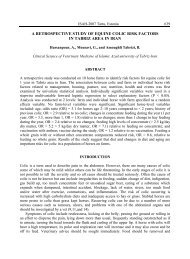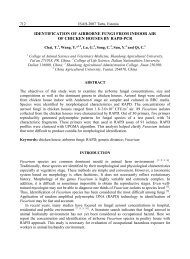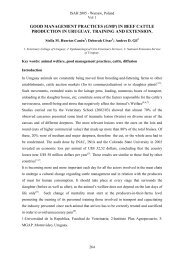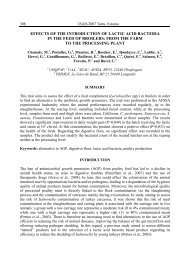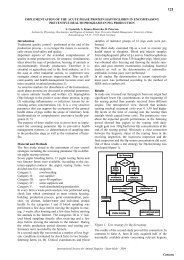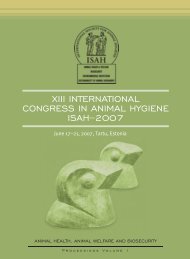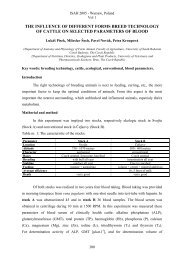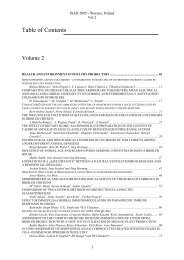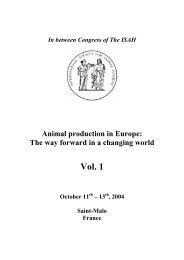monitoring environmental conditions during incubation ... - ISAH-SOC
monitoring environmental conditions during incubation ... - ISAH-SOC
monitoring environmental conditions during incubation ... - ISAH-SOC
You also want an ePaper? Increase the reach of your titles
YUMPU automatically turns print PDFs into web optimized ePapers that Google loves.
categories’ as the main effects. A significance level of 0.05<br />
was used. Means were compared using Student-Newman-<br />
Keuls multiple range (SNK) test contrasts (SAS Institute<br />
Inc., 1990).<br />
RESULTS<br />
1. Hatching parameters<br />
Hatching parameters are summarized in Table 1.<br />
Hatchability was similar for both groups. When day-old<br />
chick quality scores were taken into account, the<br />
percentage of first class chick in control group was<br />
significantly higher than that in test group.<br />
Table 1. Fertility, hatchability and first class chick proportion<br />
Test Group<br />
Fertility 1 (%) 90.48 94.88<br />
Hatchability 2 (%) 74.18 75.19<br />
First Class Chick 3 (%) 86.19 98.97<br />
1<br />
Fertility expressed as percentage of eggs set.<br />
2<br />
Hatchability expressed as percentage of fertile eggs.<br />
3<br />
First Class Chick expressed as percentage of hatching chicks.<br />
control Group<br />
2. Eggshell temperature (EST)<br />
The status of the eggs with attached temperature sensors<br />
was determined after hatch. There were three categories<br />
of eggs: unfertilized (UN), dead embryos (D), and<br />
hatching chicks (H). The EST of 3 categories of eggs<br />
showed no significant difference <strong>during</strong> the first 11 days.<br />
However, egg status showed difference in EST at day 18,<br />
19 and 20 (Table 2). The EST of hatching eggs is higher<br />
than the EST of eggs with dead embryos and unfertilised<br />
eggs (P ≤ 0.05).<br />
Table 2. Eggshell temperature of three egg categories<br />
Incubation time(day) H-mean D-mean UN-mean<br />
18 37.3±0.12 a 36.6±0.12 b 36.43±0.15 b<br />
19 38.32±0.13 a 37.64±0.13 b 37.47±0.16 b<br />
20 37.7±0.12 a 37.09±0.12 b 36.97±0.15 b<br />
3. Hatching process<br />
The hatching time of first chick in the control group is at<br />
day 19 and 11 hours (19.11) compared to 19.22 in the<br />
test group (11 hours later (). Most chicks had hatched by<br />
20.17 in the control group compared to 21.06 in the test<br />
group. Thus the total length of hatching times (hatch<br />
window) for control and test groups are 30 hours and 32<br />
hours, respectively?<br />
Figure 3. Number of hatching chicks at different <strong>incubation</strong> time<br />
DISCUSSION<br />
Temperature sensors capture the EST <strong>during</strong> the complete<br />
<strong>incubation</strong> and show the division of EST of three egg<br />
statuses (unfertilised, dead and hatching). Due to an<br />
increased metabolism, piping action and hatching<br />
movement, the embryo increases heat production at the<br />
latter part of <strong>incubation</strong> which maintains the eggshell<br />
temperature <strong>during</strong> transfer, at day 19 and 20. Thus EST<br />
is significant lower in eggs housing dead embryos and



